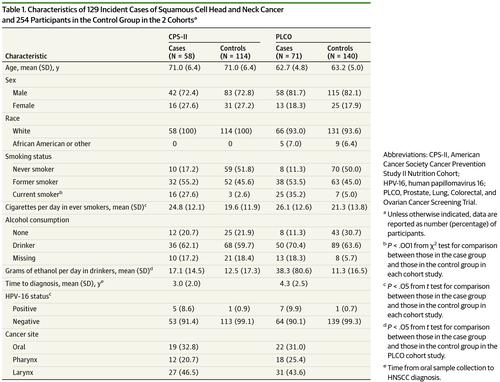JAMA Oncology ( IF 28.4 ) Pub Date : 2018-03-01 , DOI: 10.1001/jamaoncol.2017.4777 Richard B Hayes 1, 2 , Jiyoung Ahn 1, 2 , Xiaozhou Fan 1 , Brandilyn A Peters 1 , Yingfei Ma 3 , Liying Yang 4 , Ilir Agalliu 5 , Robert D Burk 5, 6 , Ian Ganly 7 , Mark P Purdue 8 , Neal D Freedman 8 , Susan M Gapstur 9 , Zhiheng Pei 2, 10, 11

|
Importance Case-control studies show a possible relationship between oral bacteria and head and neck squamous cell cancer (HNSCC). Prospective studies are needed to examine the temporal relationship between oral microbiome and subsequent risk of HNSCC.
Objective To prospectively examine associations between the oral microbiome and incident HNSCC.
Design, Setting, and Participants This nested case-control study was carried out in 2 prospective cohort studies: the American Cancer Society Cancer Prevention Study II Nutrition Cohort (CPS-II) and the Prostate, Lung, Colorectal, and Ovarian Cancer Screening Trial (PLCO). Among 122 004 participants, 129 incident patient cases of HNSCC were identified during an average 3.9 years of follow-up. Two controls per patient case (n = 254) were selected through incidence density sampling, matched on age, sex, race/ethnicity, and time since mouthwash collection. All participants provided mouthwash samples and were cancer-free at baseline.
Exposures Oral microbiome composition and specific bacterial abundances were determined through bacterial 16S rRNA gene sequencing. Overall oral microbiome composition and specific taxa abundances were compared for the case group and the control group, using PERMANOVA and negative binomial generalized linear models, respectively, controlling for age, sex, race, cohort, smoking, alcohol, and oral human papillomavirus-16 status. Taxa with a 2-sided false discovery rate (FDR)-adjusted P-value (q-value) <.10 were considered significant.
Main Outcomes and Measures Incident HNSCC.
Results The study included 58 patient cases from CPS-II (mean [SD] age, 71.0 [6.4] years; 16 [27.6%] women) and 71 patient cases from PLCO (mean [SD] age, 62.7 [4.8] years; 13 [18.3%] women). Two controls per patient case (n = 254) were selected through incidence density sampling, matched on age, sex, race/ethnicity, and time since mouthwash collection. Head and neck squamous cell cancer cases and controls were similar with respect to age, sex, and race. Patients in the case group were more often current tobacco smokers, tended to have greater alcohol consumption (among drinkers), and to be positive for oral carriage of papillomavirus-16. Overall microbiome composition was not associated with risk of HNSCC. Greater abundance of genera Corynebacterium (fold change [FC], 0.58; 95% confidence interval [CI], 0.41-0.80; q = .06) and Kingella (FC, 0.63; 95% CI, 0.46-0.86; q = .08) were associated with decreased risk of HNSCC, potentially owing to carcinogen metabolism capacity. These findings were consistent for both cohorts and by cohort follow-up time. The observed relationships tended to be stronger for larynx cancer and for individuals with a history of tobacco use.
Conclusions and Relevance This study demonstrates that greater oral abundance of commensal Corynebacterium and Kingella is associated with decreased risk of HNSCC, with potential implications for cancer prevention.
中文翻译:

口腔微生物组与头颈部鳞状细胞癌风险的关联
重要性 病例对照研究表明口腔细菌与头颈部鳞状细胞癌 (HNSCC) 之间可能存在关系。需要进行前瞻性研究来检查口腔微生物组与随后 HNSCC 风险之间的时间关系。
目的 前瞻性研究口腔微生物组与 HNSCC 事件之间的关联。
设计、设置和参与者 这项嵌套病例对照研究在 2 个前瞻性队列研究中进行:美国癌症协会癌症预防研究 II 营养队列 (CPS-II) 和前列腺癌、肺癌、结直肠癌和卵巢癌筛查试验 ( PLCO)。在 122 004 名参与者中,平均 3.9 年的随访期间发现了 129 例 HNSCC 事件患者。通过发病密度抽样选择每个患者病例(n = 254)的两个对照,根据年龄、性别、种族/民族和自漱口水收集后的时间进行匹配。所有参与者都提供了漱口水样本,并且在基线时没有癌症。
通过细菌 16S rRNA 基因测序确定口腔微生物组组成和特定细菌丰度。分别使用 PERMANOVA 和负二项式广义线性模型比较病例组和对照组的总体口腔微生物组组成和特定分类群丰度,控制年龄、性别、种族、队列、吸烟、酒精和口腔人类乳头瘤病毒 16状态。具有两侧错误发现率 (FDR) 调整的P值 ( q值) <.10 的分类群被认为是显着的。
主要结果和措施 事件 HNSCC。
结果 该研究包括来自 CPS-II 的 58 例患者(平均 [SD] 年龄,71.0 [6.4] 岁;16 [27.6%] 女性)和来自 PLCO 的 71 例患者(平均 [SD] 年龄,62.7 [4.8] 岁; 13 [18.3%] 女性)。通过发病密度抽样选择每个患者病例(n = 254)的两个对照,根据年龄、性别、种族/民族和自漱口水收集后的时间进行匹配。头颈部鳞状细胞癌病例和对照组在年龄、性别和种族方面相似。病例组中的患者更多是当前吸烟者,倾向于饮酒(在饮酒者中),并且口腔携带乳头状瘤病毒 16 呈阳性。总体微生物组组成与 HNSCC 的风险无关。棒状杆菌属的丰度更高(倍数变化 [FC],0.58;95% 置信区间 [CI],0.41-0.80;q = .06)和Kingella(FC,0.63;95% CI,0.46-0.86;q = .08)与降低有关HNSCC 的风险,可能是由于致癌物质的代谢能力。这些发现对于两个队列和队列随访时间都是一致的。对于喉癌和有烟草使用史的个体,观察到的关系往往更强。
结论和相关性 本研究表明,口腔共生棒状杆菌和金氏杆菌的丰度增加与 HNSCC 风险降低有关,对癌症预防具有潜在意义。

























 京公网安备 11010802027423号
京公网安备 11010802027423号